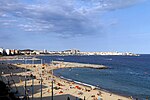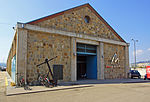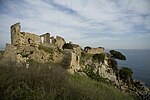Calonge

Calonge is a municipality in the comarca of the Baix Empordà in Catalonia, Spain, on the coastline of the Costa Brava. The town comprises two parts, a medieval hill village and modern seaside resort. The main urban centre and original village is about 4 km inland from the Bay of Sant Antoni. The towers and walls of Calonge castle date from the thirteenth century. Sant Antoni de Calonge, a resort, lies on the coast between Sant Feliu de Guíxols and Palamós. The two parts are connected by GI-660 which then leads north through Las Gavarres mountains to La Bisbal d'Empordà. The C-31, the main north-south route through the Costa Brava splits the two parts. Some of the bests campsites of the Costa Brava are located here, such as Cala Gogo, Treumal and International Calonge.
Excerpt from the Wikipedia article Calonge (License: CC BY-SA 3.0, Authors, Images).Calonge
Baixada de la Premsa, Calonge i Sant Antoni
Geographical coordinates (GPS) Address Nearby Places Show on map
Geographical coordinates (GPS)
| Latitude | Longitude |
|---|---|
| N 41.8625 ° | E 3.0763888888889 ° |
Address
Baixada de la Premsa
Baixada de la Premsa
17251 Calonge i Sant Antoni
Spain
Open on Google Maps









